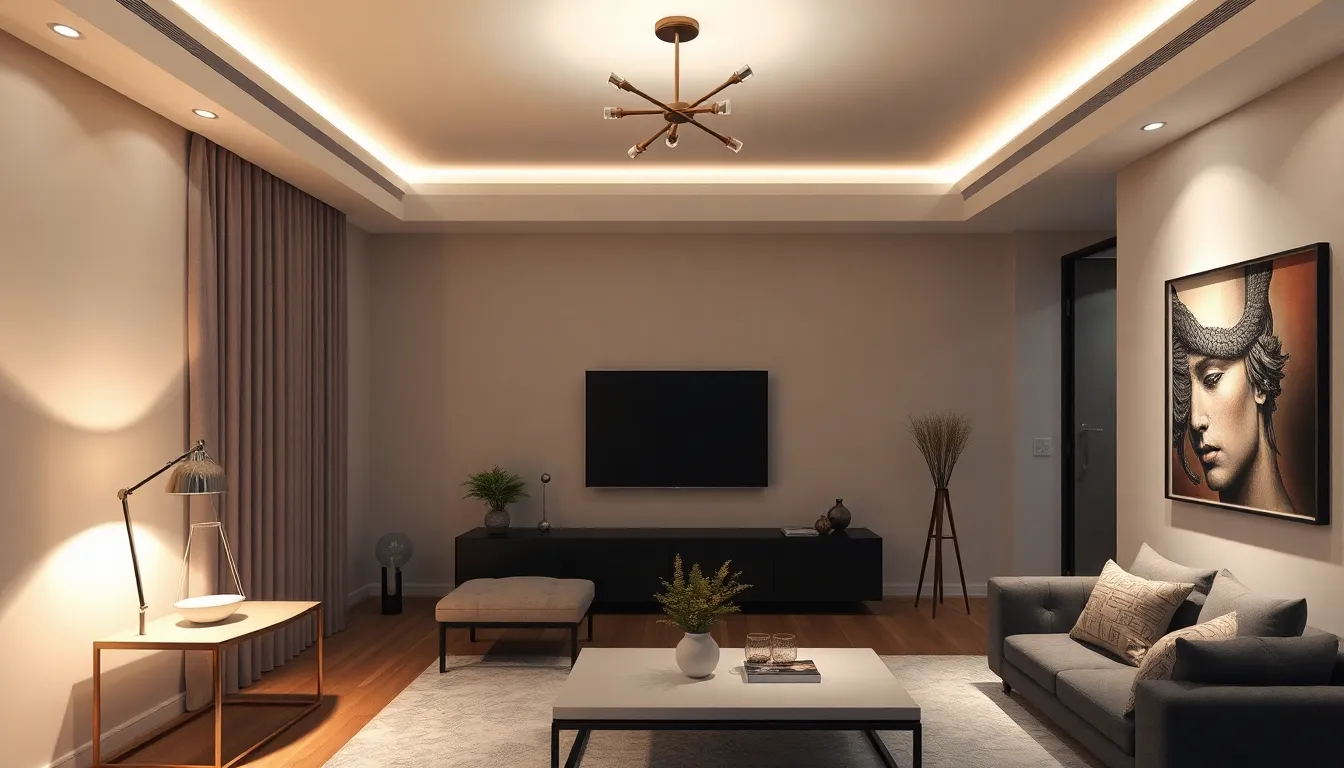Creating the perfect ambiance in a space goes beyond just a single overhead light. A layered lighting strategy combines various light sources to enhance functionality and aesthetics. By integrating ambient, task, and accent lighting, one can transform any room into a dynamic environment that caters to different activities and moods.
This approach not only improves visibility but also adds depth and character to interiors. Whether it’s a cozy living room or a bustling kitchen, understanding how to balance these lighting types can elevate the overall design. Dive into the essentials of layered lighting and discover how to illuminate spaces effectively while reflecting personal style.
Table of Contents
ToggleUnderstanding Layered Lighting Strategy
Layered lighting strategy involves combining different types of lighting to create a balanced and adaptable environment. This approach not only enhances visibility but also contributes to the overall aesthetic and mood of a space.
Definition and Importance
Layered lighting refers to the strategic use of multiple lighting sources, including ambient, task, and accent lighting. This strategy is vital for achieving a harmonious atmosphere, accommodating various activities, and influencing the emotional tone of a room. By implementing a layered approach, individuals can ensure each area of a space is well-lit for its specific function while adding visual interest.
Key Components of Layered Lighting
- Ambient Lighting: Provides overall illumination and ensures every corner of a room is visible. It often comes from ceiling fixtures, chandeliers, or recessed lights that establish a foundational light level.
- Task Lighting: Designed for specific activities, task lighting focuses on areas where detailed work occurs, such as reading or cooking. Examples include desk lamps, under-cabinet lights, and pendant lights over workspaces.
- Accent Lighting: Highlights particular features or elements in a room, such as artwork or architectural details. This lighting creates visual drama and depth, using fixtures like spotlights or picture lights to draw attention.
Each component plays a crucial role in creating a dynamic lighting scheme that enhances both functionality and style within any space.
Types of Layered Lighting


Layered lighting consists of three main types: ambient, task, and accent lighting. Each type serves a distinct purpose, enhancing functionality and aesthetics in a space.
Ambient Lighting
Ambient lighting serves as the foundation of any lighting plan. It offers general illumination, ensuring all areas of a room are visible. Sources often include ceiling fixtures, chandeliers, and wall-mounted lights. Ambient lighting creates a warm and inviting atmosphere while allowing for seamless movement throughout the space. Examples include recessed lighting and LED ceiling panels.
Task Lighting
Task lighting focuses on specific activities that require additional illumination. It enhances visibility for detailed tasks, such as reading, cooking, or working. Popular sources include desk lamps, under-cabinet lights, and focused sconces. Task lighting ensures comfort and efficiency in accomplishing everyday activities. For instance, a well-placed desk lamp can reduce eye strain during late-night reading or paperwork.
Accent Lighting
Accent lighting emphasizes specific features within a room, creating visual interest and drama. This type of lighting draws attention to artwork, architectural details, or decorative elements. Sources of accent lighting include spotlights, track lighting, and wall-mounted fixtures aimed at focal points. It adds depth and dimension to spaces, making them feel more dynamic while highlighting personal style. For example, a spotlight can create an engaging display of a sculpture or painting.
Benefits of Layered Lighting Strategy
Layered lighting offers numerous advantages, enhancing both the look and efficiency of a space. This approach not only beautifies interiors but also optimizes usage for various activities.
Enhancing Aesthetics
Layered lighting significantly elevates a room’s aesthetic appeal. By combining ambient, task, and accent lighting, spaces gain depth and visual interest. For instance, strategic accent lighting draws attention to artwork or architectural features, creating focal points. Different color temperatures, such as warm and cool hues, enrich the atmosphere, allowing for a tailored mood. Additionally, layering various types of lighting cultivates a dynamic environment that adapts to the user’s needs.
Improving Functionality
Layered lighting enhances the functionality of a space by providing adequate illumination for different tasks. Task lighting, such as focused desk lamps or under-cabinet lights, improves visibility for activities that require precision, like reading or cooking. Ambient lighting ensures uniform brightness, promoting comfort throughout the area. Moreover, combining these layers allows users to tailor the lighting based on time of day and activity, ensuring optimal conditions for productivity and relaxation.
Energy Efficiency
Layered lighting supports energy efficiency by allowing for greater control over illumination. Selectively using task and accent lighting can reduce reliance on ambient lighting, lowering overall energy consumption. By utilizing LED fixtures, individuals can further enhance energy savings while achieving desired light levels. Employing dimmer switches also facilitates adjustable brightness, maximizing energy efficiency according to specific needs. This strategic use of lighting not only cuts down on electricity costs but also extends the lifespan of lighting fixtures.
Implementing a Layered Lighting Strategy
Implementing a layered lighting strategy requires careful planning and consideration of various factors that influence both aesthetics and functionality. This section highlights essential steps to create an effective lighting layout.
Assessing Your Space
Assessing a space involves analyzing its size, shape, color scheme, and existing furnishings. Measuring dimensions helps determine lighting needs and identify potential areas for improvement. Noting natural light sources informs decisions on how much artificial lighting is necessary. Observing how the space is used at different times of day reveals specific lighting requirements for various activities, such as reading, working, or entertaining. This comprehensive assessment allows for a tailored approach to lighting that enhances the overall ambiance.
Choosing the Right Fixtures
Choosing the right fixtures plays a critical role in achieving a cohesive layered lighting strategy. Selecting ambient lighting fixtures, like ceiling-mounted chandeliers or flush mounts, creates a broad light distribution. For task lighting, options like under-cabinet lights, desk lamps, or swing-arm wall lamps provide focused illumination where it’s needed. Accent lighting fixtures, such as wall sconces or track lighting, draw attention to artwork or architectural elements. Incorporating dimmable fixtures allows for adjustable brightness, facilitating mood changes throughout the day.
Layering Techniques
Layering techniques involve combining different types of lighting to create depth and interest in a space. Implementing a combination of ambient, task, and accent lighting ensures a well-balanced approach. Using dimmers for ambient lights allows for adjustments based on the time and activity. Positioning task lights strategically helps minimize shadows while providing adequate illumination for detail-oriented tasks. Arranging accent lights to highlight specific decor or architectural features enhances visual appeal. Mixing warm and cool light temperatures can also create an inviting atmosphere, ensuring the space feels cohesive and functional.





